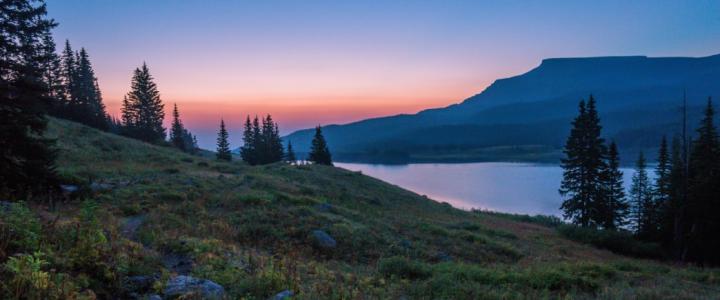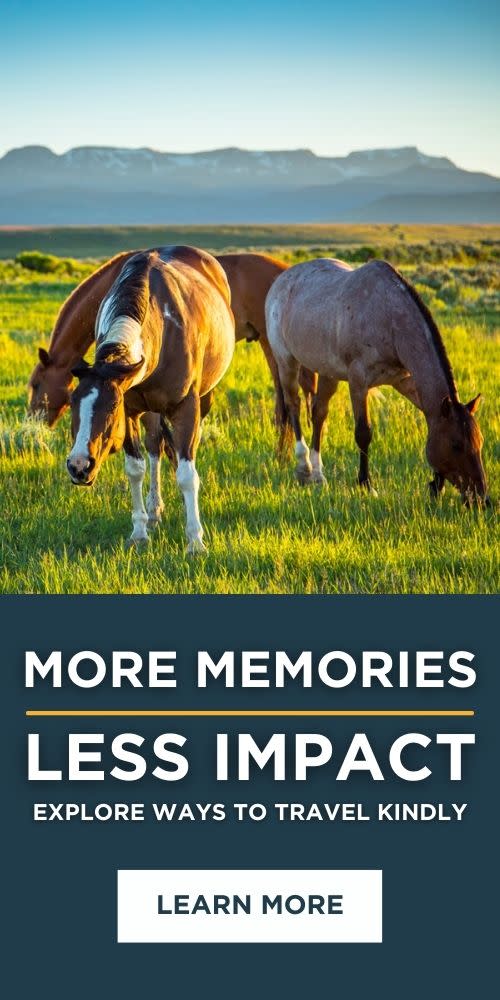
Trappers Lake, stretching across the northern edge of the Flat Top Wilderness Area, is one of Colorado’s most pristine wilderness spots. The lake area, despite being torched by a wildfire almost 20 years ago, is a marvelous region surrounded by flat-topped mountains, dotted with more than 110 lakes, blanketed by wildflower-filled meadows, and blessed with unspoiled views. The hiking is superb—if not a bit challenging at times (on one particular ridge, cowboys once blindfolded their horses so they wouldn’t spook crossing a vertiginous stretch)—as is the fishing; in fact, according to some accounts, Trappers Lake has the largest population of cutthroat trout in the world.
Beyond its pull as a recreational hub, Trappers Lake also figures prominently in the story of American wilderness preservation, thanks to a young landscape architect whose vision helped spare the region from development. As a result of his vision, Trappers Lake and the Flat Tops Wilderness remains a place to get outside and explore a pristine world far from towns and cities, a place of quiet meditation and stunning natural beauty. Here are our suggestions to explore Trappers Lake and discover the hidden secrets of this incredible wilderness.
Driving the Flat Tops Trail Scenic Byway
The 82-mile Flat Tops Trail Scenic Byway, a backcountry road connecting Yampa to Meeker, twists along the northern edge of the Flat Tops, one of Colorado’s most unusual mountain ranges. The Flat Tops are exactly that: a range of flat-topped mountains capped with ancient lava flows. The byway, beginning at Yampa south of Steamboat Springs, climbs over Dunckley and Ripple Creek Passes from the Yampa River Valley and then dips into the White River’s deep canyon to Meeker. The scenic route crosses the ancestral homeland of the Ute tribe, passes the second-oldest national forest in the United States, and offers spectacular overlooks and mountains covered with aspen gold in September. Drive the Flat Tops Trail from Yampa south of Steamboat Springs to a side road that leads to Trappers Lake, the second-largest natural lake in Colorado.
Exploring Trappers Lake

Glistening like a gem, Trappers Lake is a huge lake cradled in the Amphitheatre, a semi-circular valley encased by cliffs and mountains. The remote lake offers world-class trout fishing, quiet campsites, the famed Trappers Lake Lodge, non-motorized boating, and miles of hiking trails to lakes, plateaus, and peaks. It also serves as the jumping-off point to explore the Flat Tops Wilderness, a remote upland filled with wildlife, dramatic views, and solitude. More than 17,000 acres of the area’s old-growth forest was ravaged by the Big Fish Fire in 2002, but the spruce, fir, and pine are slowly growing back among toppled, charred tree trunks.
Trappers Lake and the Wilderness Idea
Trappers Lake figures prominently in the preservation of undisturbed public lands as wilderness. After protection as America’s second national forest in 1891, the US Forest Service decided to develop Trappers Lake as a recreational playground with cabins, lodges, dude ranches, and a loop road around the lake. They hired Arthur Carhart, a young landscape architect, to study the planned development in 1919. After exploring the area, Carhart recommended that the area should be preserved as wilderness with no development within a half-mile of the lakeshore, writing that Trappers Lake “should be preserved for all time for the people of the Nation and the world.” The Forest Service accepted his recommendation and dropped plans for roads and ranches. Trappers Lake was protected in 1929 as part of the Flat Tops Primitive Area, which became Colorado’s third-largest wilderness area in 1975.
Discovering the Wonders of Trappers Lake
The accessible lake still offers a wilderness experience. Five forest campgrounds—Bucks, Cutthroat, Horsethief, Shepherds Rim, and Trapline—sit on ridges north of Trappers Lake. The 9,627-foot-high lake is reached by the Arthur H. Carhart Trail, a 5.25-mile footpath that loops around the long lake and offers stunning scenery and fishing access. Anglers consider Trappers Lake one of Colorado’s best high-altitude lakes with plentiful native cutthroat trout, supposedly the largest population in the world, which naturally reproduce in the clear water. Fishing is allowed only with flies and lures and cutthroats over 10 inches must be released. Time your angling to the prolific mayfly, caddis, and midge hatches to catch the 8-bag limit on small cutts or the unlimited bag on brook trout. Trappers Lake is perfect for paddlers, with quiet coves and inlets as well as open water. A grand adventure is making the three-hour paddle around the lake’s shoreline in a canoe or kayak. Tote your boat from the Trappers Outlet Trailhead or rent a canoe, kayak, or paddleboard from the General Store at Trappers Lake Lodge. Birders flock to the lake to glimpse the breeding population of Barrow’s Goldeneyes and many woodpeckers, including the American three-toed woodpecker, in burned tree snags.
Trappers Lake Lodge and Resort
The Trappers Lake Lodge and Resort, lying in the valley north of the lake, dates to the first rental cabins in the mid-1880s. The lodge slowly grew as an enclave of civilization amid wild mountains, with a spacious lodge and log cabins. After the fire, which burned down the main lodge, the Forest Service planned to demolish the place until two sisters bought it in 2005 and turned it around. Now Trappers Lake Lodge is busy with rented cabins from June through October. It’s also a complete outfitter, offering guided fishing, boating, horseback rides, and wilderness camping escapes. Lake visitors can also dine at the restaurant and bar, take a hot shower, or ask for local advice.

Hiking the Trappers Lake Area
The Trappers Lake area is a hiking and backpacking paradise, with more than 160 miles of trails threading through the Flat Tops Wilderness Area. There’s no better way to explore Trappers Lake country than lacing up boots and heading up a trail to find lakes reflecting clouds, herds of elk, and 360-degree panoramic views. Hike the Carhart Trail around Trappers Lake, or follow the Wall Lake Trail onto a high plateau to Wall Lake and Star Lake. Finish by hiking down Trappers Lake Trail to the lakeside trailhead.
A lovely trek follows the three-mile Skinny Fish Lake Trail to its namesake and McGinnis Lake below a cliff-lined cirque. The best hike climbs Little Trappers and Chinese Wall Trails to the mile-long Devil’s Causeway Trail, a thrilling walk in the clouds across a narrow ridgeline perched above vertical 80-foot cliffs. Watch your step where the ridge thins to a mere three feet wide.
5 Flat Top Wonders
Besides wind-rippled Trappers Lake, the Flat Tops abound in natural and historic wonders.
• Devil’s Causeway is a vertigo-inducing basalt ridge that connects two plateaus on the crest of the Flat Tops. Over 800 feet of thin air lies below the rocky ridge. While horses aren’t allowed on it these days, cowboys from bygone eras blindfolded their steeds to lead them across the nerve-wracking traverse.
• The Chinese Wall, Colorado’s answer to the Great Wall of China, is a seven-mile-long stretch of banded basalt cliffs deposited as ancient lava flows. The west-facing escarpment looms east of Trappers Lake.
• Trappers Peak, a 12,002-foot mountain southwest of Trappers Lake, towers over Wall and Star Lakes and open meadows fringed with spruce and fir. Scramble up the peak in July for a jaw-dropping display of wildflowers, including elegant columbines, the Colorado state flower.
• Ripple Creek Overlook, sitting atop 10,343-foot Ripple Creek Pass on the Flat Tops Trail Scenic Byway, yields expansive views into the Flat Tops and Trappers Lake area, as well as west down the White River Valley. Check out interpretative signs for info on geology, natural history, wildlife, and the wilderness concept.
• The Pyramid Guard Station, hiding in aspens along the Williams Fork River and the Flat Tops Trail, is a Forest Service center built by the Civilian Conservation Corps in the 1930s. The buildings, listed on the National Register of Historic Places, include a barn, woodshed, office, and blacksmith shop built in a style of architecture known as Rustic, with small windows, log walls, and log eaves.
Written by Stewart Green for Matcha in partnership with Steamboat Springs Chamber






